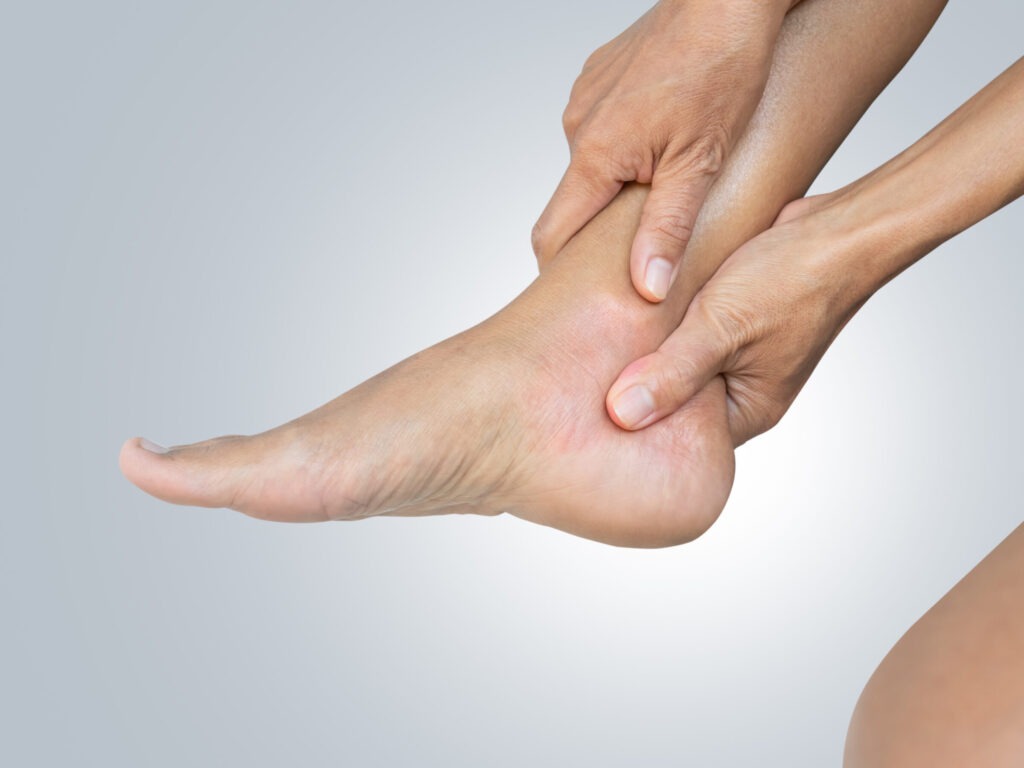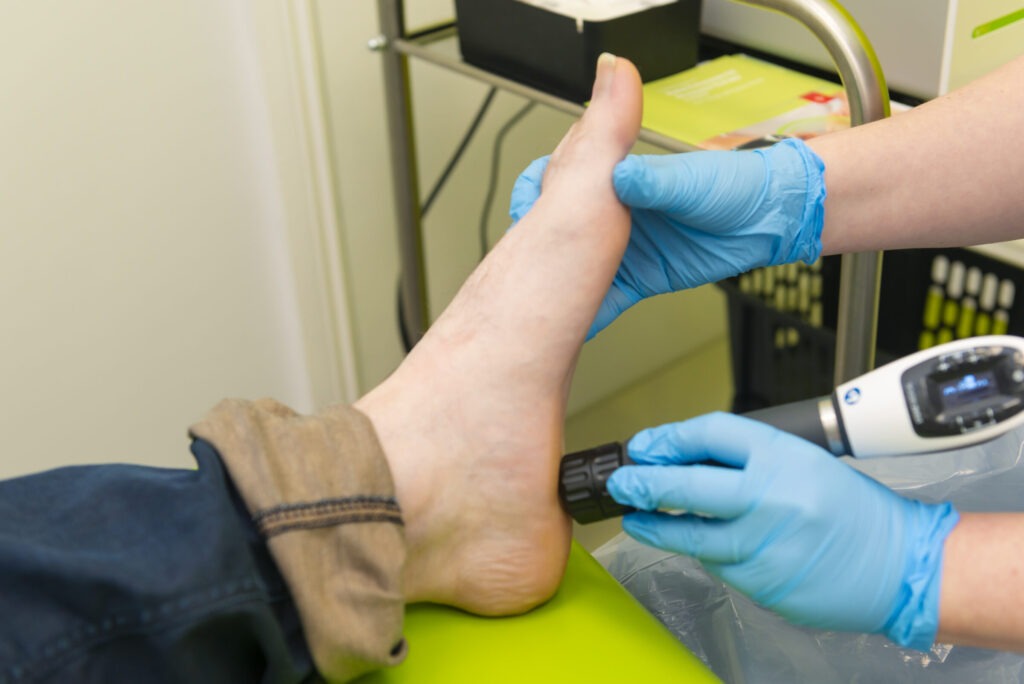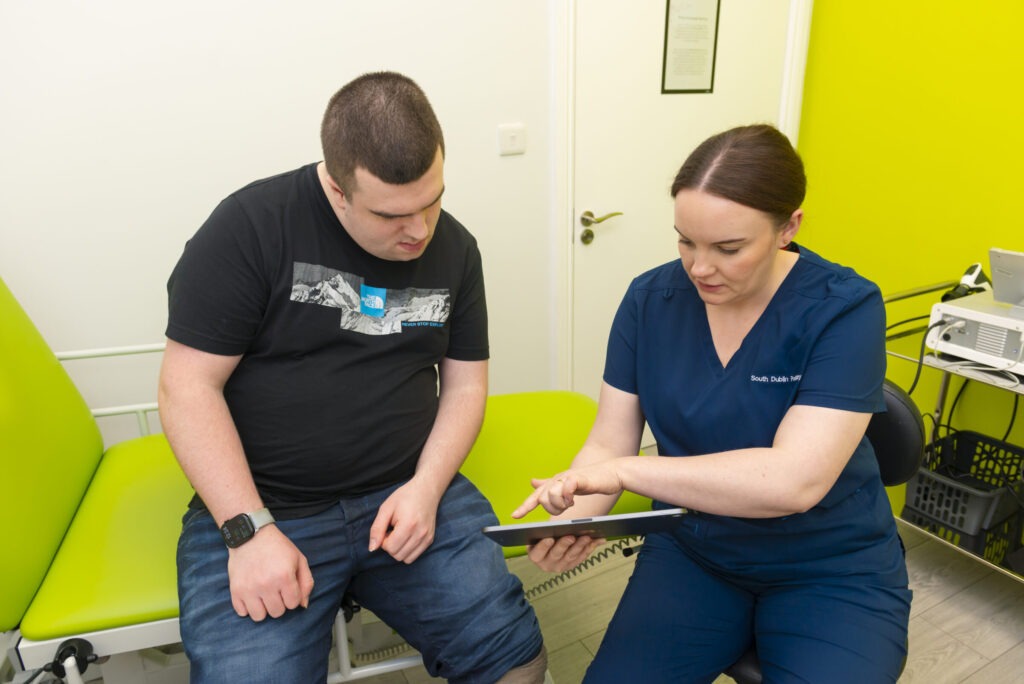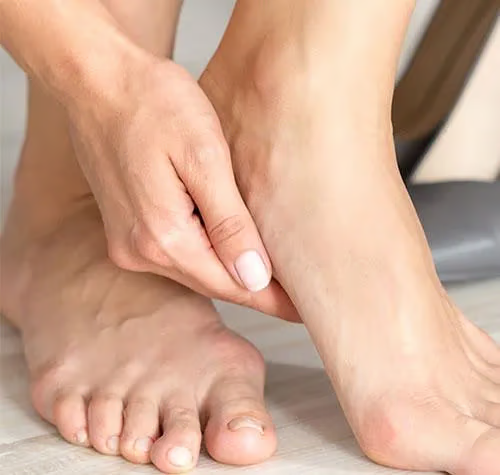
At South Dublin Podiatry, we understand how debilitating heel pain can be—whether it strikes first thing in the morning, after sitting for a while, or during everyday activities. If you’ve tried multiple clinics, spent money on orthotics that didn’t work, or been told that an injection is your only option, you’re not alone. Persistent heel pain can make even a short walk unbearable and leave you wondering if you’ll ever return to the activities you love. Our expert team specialises in effective, long-term solutions to help you move comfortably again.
Plantar fasciitis—also known as plantar fasciopathy or plantar heel pain—is the most common type of heel pain we see in adults at South Dublin Podiatry. It usually causes discomfort along the inside of the heel, particularly with the first steps in the morning or after resting, though the pain often eases as you move around. This condition is often linked to poor foot mechanics, prolonged standing, inappropriate footwear, or a sudden increase in activity. While it can become a persistent issue if left untreated, it responds very well to the right treatment.

In children, the most common type of heel pain we see is Sever’s disease, also known as calcaneal apophysitis. This condition typically affects active kids during growth spurts and causes pain at the back of the heel, especially during or after sports and physical activity. It’s caused by inflammation where the Achilles tendon attaches to the heel bone, often triggered by repetitive stress from running and jumping. Although it can be quite painful, Sever’s is temporary and usually resolves with rest, proper footwear, and activity modification.
With over 40 possible causes of heel pain, the first step is getting assessed by a specialist to identify the exact issue. At South Dublin Podiatry, initially we carry out a detailed biomechanical assessment. From there, we create a personalised treatment plan tailored to your needs. Our expert team uses gold-standard, evidence-based treatments—including custom made foot orthotics, footwear advice, taping, manual therapy, rehab and shockwave therapy—to help you recover and get back on your feet.

Our experienced and knowledgeable practitioners will examine the following to identify exactly what is causing your heel pain :
Our orthotics are designed with the latest cutting edge technology, to get you back to normal and doing the things you love.
At South Dublin Podiatry, our team of heel pain experts understands that each person’s needs are unique. That’s why we often create individualised rehab programmes to ensure you get the most out of your orthotics when needed for heel pain.
And if you want to take a break from wearing your orthotics and slip into those nice shoes you’ve been eyeing, we can help make that possible too!
Our goal is to provide treatments that are gentle and progressive, allowing you to recover from heel pain and resume your favorite activities as quickly as possible, without experiencing any pain.
We want to help you overcome the limitations that your heel pain has imposed on you, so that you can return to the things you love doing.
Also we don’t just want to eliminate your heel pain, we want to provide you with the knowledge and resources necessary to prevent it from returning in the future.
Here’s just a few of the things our Podiatry Team can do for you:

South Dublin Podiatry boasts a team of highly qualified and experienced podiatrists who are dedicated to providing top-notch foot and ankle care. Their expertise ensures that patients receive accurate diagnoses and personalised treatment plans tailored to their specific needs.
Whether it’s treating common foot conditions like bunions, ingrown toenails, or plantar fasciitis, or addressing more complex issues such as sports injuries or diabetic foot care, South Dublin Podiatry offers a comprehensive range of services. Patients can trust that all their foot and ankle concerns will be addressed under one roof.
South Dublin Podiatry is committed to staying at the forefront of podiatry care by investing in state-of-the-art facilities and the latest technology. This allows for more accurate assessments, advanced treatment options, and enhanced patient outcomes.
At South Dublin Podiatry, patients are the top priority. The team believes in a patient-centered approach, where they listen attentively to the concerns and goals of each individual. This ensures that the treatment plan aligns with the patient’s lifestyle and preferences, leading to better compliance and results.
Beyond just treating existing conditions, South Dublin Podiatry emphasises the importance of holistic and preventive care. They educate patients on proper foot care techniques and lifestyle adjustments to minimise the risk of future foot problems, promoting long-term foot health and overall well-being.
The reputation of South Dublin Podiatry speaks for itself through the positive feedback and testimonials from satisfied patients. Many individuals have shared their success stories and experiences, highlighting the clinic’s commitment to excellence and patient satisfaction.
Heel pain can be caused by various factors, including plantar fasciitis, Achilles tendinitis, heel spurs, stress fractures, bursitis, and nerve entrapment. It can also result from wearing improper footwear, overuse or excessive strain on the feet, and certain medical conditions such as arthritis or obesity.
Plantar fasciitis is a common cause of heel pain. It occurs when the plantar fascia, a band of tissue that runs along the bottom of the foot, becomes inflamed or irritated. This often leads to sharp or stabbing pain in the heel, especially with the first steps in the morning.
Diagnosis of heel pain involves a thorough examination by a healthcare professional. They will assess your symptoms, medical history, and perform physical tests. In some cases, imaging tests such as X-rays or ultrasound may be required to rule out underlying conditions.
Treatment for heel pain depends on the underlying cause. It may include rest, ice therapy, wearing supportive and properly fitted shoes, using orthotic inserts or heel cups, performing stretching and strengthening exercises, taking pain relievers, and undergoing physical therapy. In severe cases, medical interventions like corticosteroid injections or surgery may be recommended.
The duration of heel pain recovery varies depending on the cause and individual factors. With appropriate treatment and self-care measures, many people experience relief within a few weeks to several months. However, some conditions may require longer periods for complete resolution.
It’s important to avoid high-impact activities or exercises that worsen your heel pain. However, low-impact exercises such as swimming, cycling, or gentle stretching can often be beneficial. Consult with a healthcare professional for specific recommendations tailored to your condition.
Yes, there are several home remedies that can provide relief for heel pain. These include applying ice packs to the affected area, performing gentle stretches and massages, using over-the-counter pain-relieving creams or gels, and resting the feet whenever possible.
Yes, wearing improper footwear can contribute to heel pain. Shoes that lack proper arch support, cushioning, or stability can strain the feet and lead to various conditions that cause heel pain. It’s important to wear supportive shoes that fit well and provide adequate protection and comfort.
It is advisable to seek medical attention if your heel pain persists despite home remedies, becomes increasingly severe, affects your ability to walk or perform daily activities, or is accompanied by swelling, redness, or fever. A healthcare professional can provide a proper diagnosis and recommend appropriate treatment options.
While it’s not always possible to prevent all causes of heel pain, there are preventive measures that can help reduce the risk. These include wearing supportive shoes, maintaining a healthy weight, avoiding excessive strain on the feet, gradually increasing activity levels, and performing regular foot exercises and stretches.